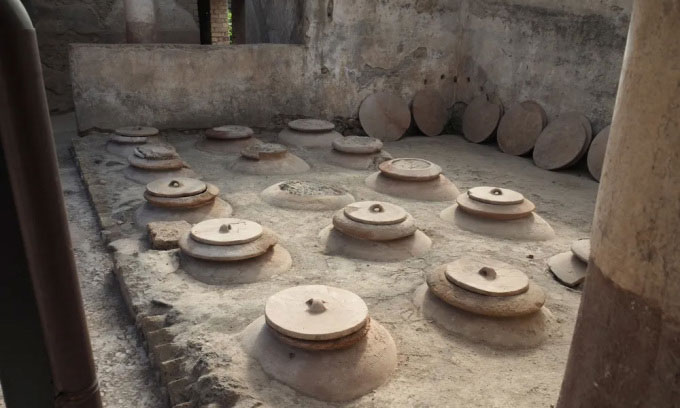Newly published research shows that Roman wine was brewed in clay jars buried underground, with a slightly spicy taste, fragrant with toasted bread, apples, toasted walnuts, and curry.
The ancient Romans (circa 8th century BC to 5th century) drank a lot of wine. Some historians estimate they drank up to a liter of diluted wine a day, more than most people in the 21st century. A new study published in the journal Antiquity helps clarify the flavor, aroma and texture. structure of this wine, Smithsonian reported on March 4. Accordingly, Roman wine has a slightly spicy taste, fragrant with toasted bread, apples, toasted walnuts and curry.
 Dolia jars buried in a wine cellar in the town of Boscoreale, Italy. (Photo: E. Dodd/Ministryo della Cultura/Parco Archaeologico di Pompei).
Dolia jars buried in a wine cellar in the town of Boscoreale, Italy. (Photo: E. Dodd/Ministryo della Cultura/Parco Archaeologico di Pompei).
In the new study, a team of scientists looked at dolia, clay vessels that the Romans used to preserve, ferment, and age wine. Historians have long known that dolia was commonly used, but many questions remained regarding the details of its production. New research shows that this type of vessel is an essential tool in winemaking techniques. This is not an ordinary container but is precisely designed with ingredients, size, and shape that all contribute to successful wine brewing.
Dolia has been a key element in ancient wine production for hundreds of years, according to Dimitri Van Limbergen, lead author of the study, an archaeologist at Ghent University. While today, many wines are produced in stainless steel tanks and have preservatives added.
The Romans buried the dolia jar in the ground, deep to the brim, and sealed it with a lid to regulate temperature, humidity, and pH during the fermentation process, according to Van Limbergen and co-author Paulina Komar, an archaeologist at the University Warsaw. Clay pots have a porous texture and are coated with tar inside, which helps tightly control the oxidation process.
Dolia has a narrow base, which allows solids from the grapes to sink to the bottom of the vessel and separate from the wine, creating an orange color. But comparing this color with modern wines is difficult, because Roman wines were not divided into red and white wines . “Roman wine comes in many different colors, from white, yellow to golden, amber, brown, red and black, all based on the type of grape soaked,” Van Limbergen explains.
The conditions created by burial of the vessel also influence the unique characteristics of the wine. Inside the jar, yeast grows on the surface of the wine, creating chemical compounds such as sotolon. These compounds provide distinctive flavors and aromas.
“Ancient wines made from white grapes and using the above techniques will certainly taste oxidized, with complex aromas of toasted bread, dried fruit (e.g. apricots), toasted nuts (walnuts, almonds), green tea, with a dry and resinous feel (there are many tannin compounds in wine from grape skins)” , Van Limbergen commented.





